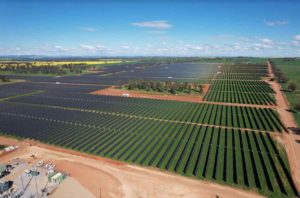We are in unchartered conditions due to the coronavirus pandemic and the resulting global recession.
Economic growth has slowed, the energy market has stalled, oil prices and the global stock market has crashed, and a virus without a vaccine is stalling human activity around the world.
In this environment, governments must show leadership.
The Australian Government is in an opportune position to reset its position on climate change, the energy market and a ‘just transition’ using the financial firepower it still retains.
Tax cuts and yet more hand-outs to large corporates are not part of this picture.
Australia must grab the reins and stimulate public and private investment and employment in the decarbonisation of our energy system, for both domestic and export markets.
Modernising and expanding the national electricity grid and flexible peaking power capacity (hydro, batteries, gas peakers and demand response) would invite tens of billions of dollars of new renewable energy investment.
And with record low interest rates, and solar module prices also down to record low prices of just US$0.20-.30/watt, the government can drive investment in building a deflationary, new energy system with massive energy export opportunities.
Slower growth is an opportunity to accelerate change.
Ramped up renewable energy momentum and wider decarbonisation efforts to increase energy efficiency are the likely bi-products.
Fossil fuels have met their match.
Oil, coal and gas/LNG project proposals are now likely to be re-evaluated, given the heightened risk of becoming stranded with subsequent pain delivered to investors, shareholders and energy consumers alike.
Global coal-fired power generation dropped 3% in 2019, the biggest decline in two decades, driven by a combination of renewable energy, gas and energy efficiency.
With coronavirus now seriously hampering global growth in 2020, it is increasingly feasible that 2018 marked the peak in global coal power generation, just as 2013 marked the peak in global coal use.
And key Australian fossil fuel export destinations like South Korea, India, Vietnam and China are increasingly adopting positions bent on driving down fossil fuel imports and are looking to embrace the opportunity that decarbonisation brings.
There is every possibility the fossil fuel sector may never recover from this collapse.
Most of the global oil and gas majors US$2 trillion capex plans for the coming decade are now mostly unviable and unbankable.
BP’s announcement of a major pivot to “net zero by 2050, or sooner”, and similar announcements by Repsol and Eni may well be a financial necessity the other majors need to follow.
Investing in more LNG export and deep sea and artic oil drilling capacity and propping up an aging coal-fired power plant fleet has become problematic from an economic perspective, putting aside the climate catastrophe each entails.
Renewables are rapidly becoming the low cost solution globally.
BNEF has outlined a 20% annual decline in average battery pack prices, falling from US$950/kWh to a forecast US$135/kWh in 2020.
No fossil fuel competitor can survive long against a 20% annual deflationary trend.
Similar to the unstoppable change occurring in the energy sector, the global surge in the uptake of electric vehicles (EV) is part of a wider technology driven disruption of the transportation sector.
Global demand for petrol and diesel vehicles is set for its third year of decline in 2020. Sustainability, reduced air pollution, total lifetime cost of ownership, and clean energy choices are driving this long term view.
A three or even twelve month drop in oil prices might slow the rate of EV uptake marginally. But it also buys time to accommodate rapid technology change and to reconfigure global supply chains from lithium ore mining to batteries to auto assembly.
There is no turning back. The energy and auto markets are converging, accelerating this transition.
The Australian government’s immediate monetary response to the current crisis has been to cut interest rates even further. Australian government 10 year bonds are now just 1.0% compared to 5.8% a decade ago (an 85% drop that can be locked in for the life of a multi-decade infrastructure project).
Dramatically lowering the cost of borrowings will accelerate the already deflationary nature of renewables. Given the cost of capital makes up the vast majority of the total lifetime cost of renewables, lower interest rates will make renewables even more competitive.
With investors seeking safe cashflow back yields, infrastructure allocations by Australian asset owners and managers are set to rise considerably, again lowering the cost of equity for renewables infrastructure.
But the government must do more.
The economic shock of the coronavirus combined with the economic slowdown means the government must ensure foreign firms operating in Australia start paying corporate taxes.
Further, now is the ideal time to cut subsidies, such as the imported diesel fuel rebate for mining firms and perpetual oil and gas royalty “holidays”. This will not affect Australian consumers but will impact tax-avoiding fossil fuel majors, providing a much needed new revenue source to help fund stimulus programs.
Australian renewable energy subsidies have already been phased out, with the renewable energy target (RET) now met. This is consistent with international trends.
China will have removed renewable energy subsidies for all new projects by the end of 2020. The U.S. market will complete its renewable energy subsidy phaseout by 2023 (the Investment Tax Credit). And since 2017, India has employed few renewable energy generator subsidies. In fact India has increasingly been subsidising thermal power generators who can no longer compete – a situation we do not want in Australia.
Investing in fossil fuels is increasingly volatile and speculative.
The collapse in LNG and oil prices has destroyed huge amounts of investor wealth. Exxon Mobil shareholders have seen a US$160bn wealth destruction 2020 year-to-date (down 50% against a U.S. equity market down 23% in this same timeframe).
In stark contrast, renewable energy infrastructure backed by cashflow certainty over a 25-year government backed power purchase agreement stands firm.
With the oil-price linkage of most historic LNG contracts, the price collapse has a knock on impact for LNG pricing. Current Asian LNG prices are below US$3/mmBtu, and proposed new LNG export developments are likely to be uneconomic on current pricing.
The 57% collapse in Santos’ share price year-to-date (against the 25% decline in the Australian equity market overall) reflects the long term shareholder wealth destruction in Australia’s oil and gas sector.
The Australian Energy Market Operator’s Integrated System Plan (ISP) has mapped the course of Australia’s energy system. Nation building investments in long dated strategic infrastructure and innovation matches the vision.
The Australian government needs to accelerate investment in the national electricity market (NEM) grid, build up interstate transmission and accelerate the timetable for pumped hydro storage. Ideally this means at least one new project in each state of Australia to best underpin grid stability and balancing.
Retrofitting Australian aluminium smelters to re-establish viability whilst also delivering massive demand response management capacity would also be ideal to lock in lower cost, lower emissions, and more reliable electricity for all.
The Australian government should use the system shock of this pandemic to sustainably change the national landscape and invest in future proofing the economy while learning from the harsh lessons of the 2019/20 bushfire disaster to improve resilience.
Returning to a low cost domestic energy system could be at the forefront of a domestic manufacturing and industry revival, leveraging the increased competitiveness that comes with the collapse of the A$ to just US$0.60.
The government should lay the foundation for an accelerated buildout of low cost, zero emissions renewable energy infrastructure in a systemic, planned way.
The map has been drawn. It is time for government to act.
Tim Buckley is IEEFA’s Director of Energy Finance Studies, Australia









